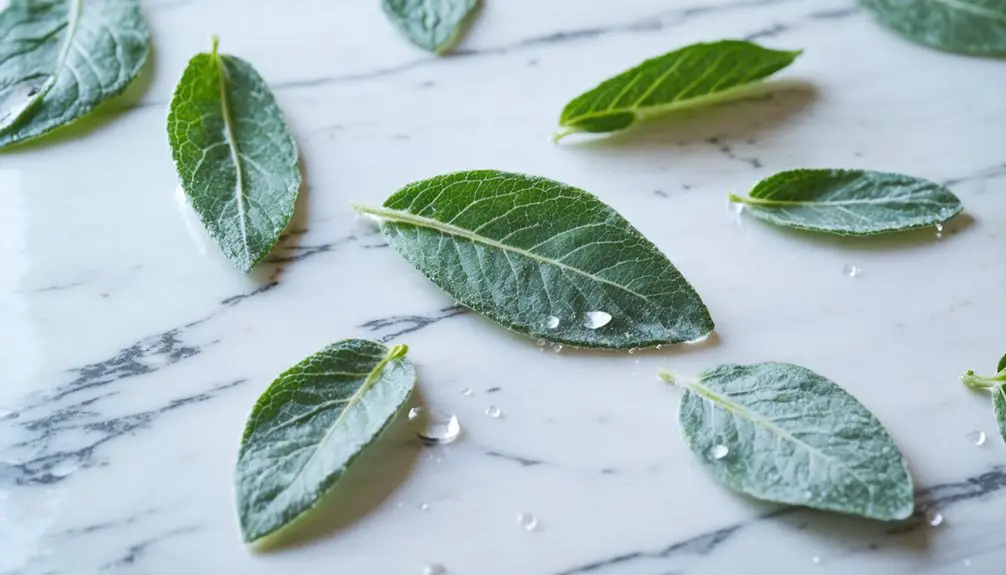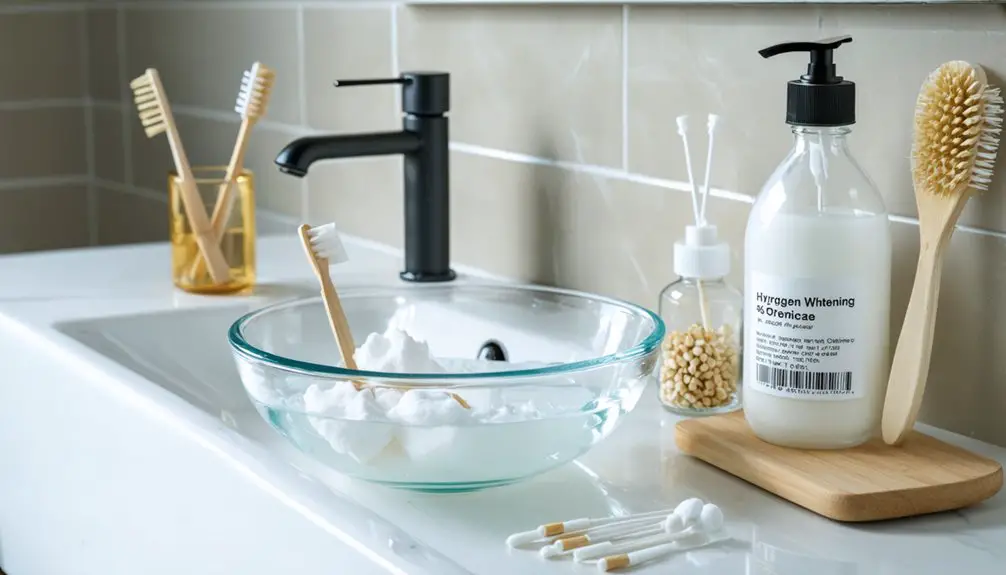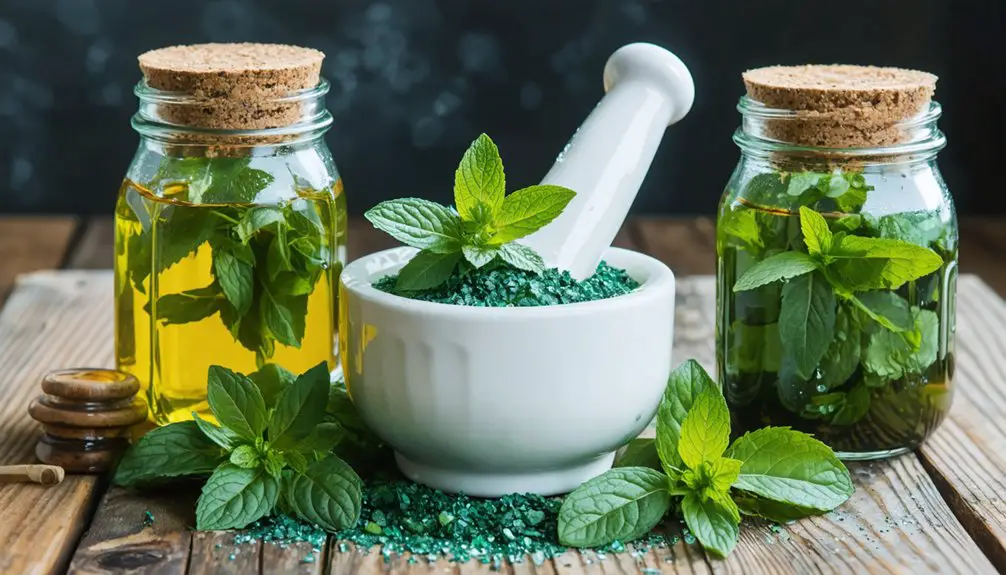You can naturally whiten your teeth using sage leaves thanks to their unique biochemical composition of rosmarinic acid and polyphenols that target stains. Clinical studies show sage’s antibacterial properties reduce harmful bacteria colonies from 3,900 to 300 in just 21 days while protecting enamel integrity. Simply grind dried leaves into powder, mix with coconut oil for a paste, or steep for mouthwash. Understanding sage’s complete oral health benefits will transform your dental care routine.
Key Takeaways
- Sage’s natural compounds, including rosmarinic acid and flavonoids, work together to break down tooth stains while preserving enamel integrity.
- Clinical studies demonstrate sage’s effectiveness in whitening teeth within 30 minutes when combined with other natural ingredients.
- Sage leaves can be used directly on teeth, made into powder, or steeped in water for various teeth whitening applications.
- Unlike harsh chemical treatments, sage provides gentle whitening action while simultaneously fighting harmful oral bacteria and promoting gum health.
- Regular use of sage leads to sustained whitening results over several weeks while improving overall oral hygiene and breath freshness.
The Science Behind Sage’s Natural Whitening Power
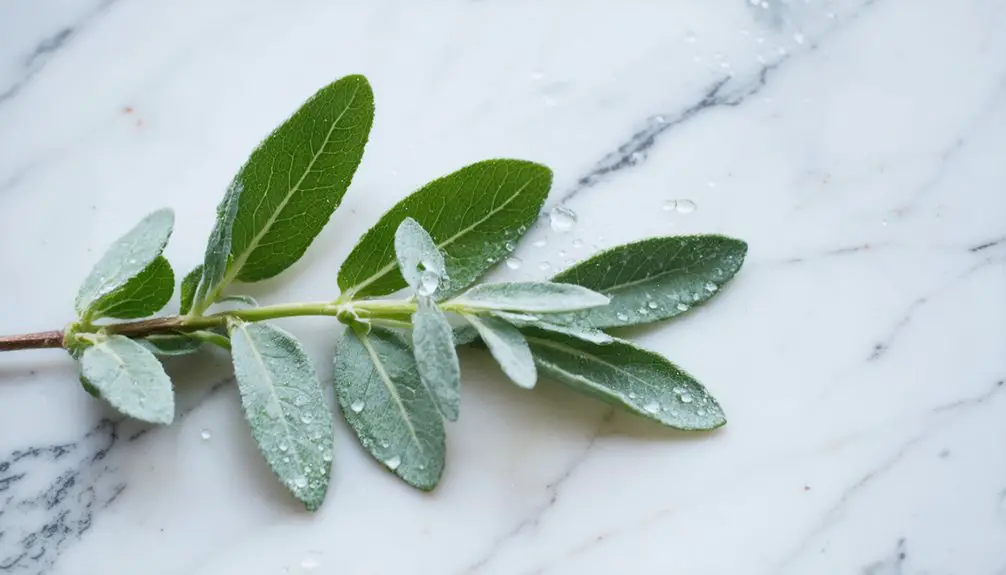
While many natural teeth whitening remedies lack scientific backing, sage’s effectiveness stems from its unique biochemical composition. You’ll find that various sage varieties contain powerful compounds like rosmarinic acid and flavonoids that naturally break down tooth stains through both chemical and mechanical actions.
When you use sage for teeth whitening, its polyphenols work as antioxidants to prevent stain oxidation, while essential oils target tannins and other discoloring compounds. Fresh or dried sage leaves can be crushed and rubbed directly on teeth for optimal results.
The whitening effectiveness comes from sage’s dual approach: its gentle abrasive properties physically remove surface stains, while its bioactive compounds chemically dissolve deeper discoloration. Additionally, sage’s natural astringent properties help tighten gums while whitening occurs.
Sage’s natural whitening power lies in its two-part action: gentle scrubbing of surface stains plus deep chemical breakdown of discoloration.
What makes sage particularly valuable is its ability to maintain enamel integrity during the whitening process, unlike harsh chemical alternatives that can erode tooth structure.
Understanding Sage’s Antibacterial Properties for Oral Health
Your oral health benefits from sage’s powerful antibacterial compounds, particularly carnosic acid and carnosol, which target Streptococcus mutans – the primary bacterium responsible for tooth decay.
Clinical studies show that sage mouthwash can reduce S. mutans colonies from approximately 3,900 to 300 in just 21 days, effectively decreasing plaque formation and protecting your enamel. The gentle extraction process of sage leaves ensures maximum preservation of these beneficial compounds.
Sage has proven especially effective at treating gum infections and ulcers when used as part of a regular oral care routine.
Fighting Oral Bacteria Naturally
As scientific research continues to validate traditional wisdom, sage’s remarkable antibacterial properties have emerged as a powerful natural solution for maintaining oral health.
When you incorporate sage compounds into your oral hygiene routine, you’re harnessing a complex arsenal of bioactive elements including essential oils, flavonoids, and phenolic acids that effectively combat harmful bacteria.
These natural compounds work by disrupting bacterial cell membranes, particularly targeting Streptococcus mutans, the primary culprit behind tooth decay. The presence of carnosic acid makes sage especially effective at penetrating and destroying harmful oral pathogens.
Clinical trials have shown that sage-based mouthwash can dramatically reduce bacterial colonies from 3,900 to just 300 per plaque sample within 21 days.
What makes sage particularly valuable is its balanced approach – it’s gentler than other natural antimicrobials while still delivering potent antibacterial effects through its unique combination of active compounds.
Plaque Reduction With Sage
Through extensive clinical research, sage has demonstrated remarkable efficacy in reducing dental plaque formation by targeting specific bacterial populations.
The key sage extract benefits stem from its rich composition of carnosic acid, carnosol, and thujone, which work synergistically to disrupt bacterial cell membranes and inhibit Streptococcus mutans growth.
The antibacterial mechanisms of sage are particularly effective against gram-positive bacteria, with clinical trials showing significant reductions in bacterial colonies from 3,900 to 300 after just 21 days of use.
You’ll find that sage’s natural compounds not only combat harmful bacteria but also help prevent their adhesion to teeth.
Additionally, sage’s antioxidant and anti-inflammatory properties create an environment that’s inhospitable to plaque-forming bacteria while supporting overall gum health.
Preventing Tooth Decay Effectively
Scientific evidence has established sage’s powerful role in preventing tooth decay through its unique combination of antibacterial compounds.
The remarkable antibacterial efficacy of sage stems from its essential oils, flavonoids, and compounds like carnosic acid and carnosol, which actively disrupt harmful bacteria in your mouth.
Clinical trials demonstrate that sage benefits extend beyond basic oral care, showing significant reductions in Streptococcus mutans colonies – the primary cause of tooth decay.
- Sage mouthwash reduces S. mutans colonies from 3,900 to 300 in just 21 days
- Essential oils and compounds target bacterial cell membranes effectively
- Anti-inflammatory properties protect gum tissue while fighting bacteria
- Regular use helps maintain ideal oral flora balance and prevents enamel erosion
How to Prepare Sage Leaves for Teeth Whitening
Preparing sage leaves for teeth whitening involves several effective methods, each offering unique benefits for oral care.
You’ll find multiple sage preparation techniques, from drying and grinding the leaves into a fine powder to creating therapeutic mouthwashes through steeping.
To create a whitening powder, dry your sage leaves completely before grinding them. You can mix this powder with salt or baking soda for enhanced stain removal.
For sage application methods using fresh leaves, gently rub them directly on your teeth to remove surface stains. This natural solution is particularly effective since enamel is porous and readily accepts the whitening properties. The herb’s antibacterial properties make it especially beneficial for long-term oral health. Alternatively, steep dried leaves in boiling water to make a natural mouthwash that helps reduce plaque.
For a paste-like consistency, blend your sage powder with coconut oil or water.
Remember to use these preparations regularly but moderately to protect your enamel while achieving ideal whitening results.
Comparing Sage to Chemical Whitening Treatments
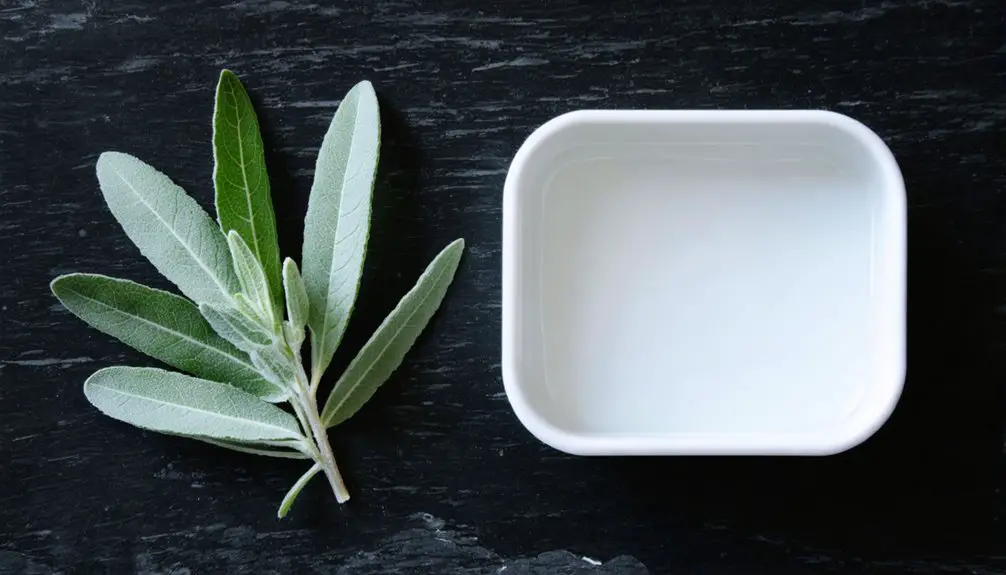
While chemical whitening treatments with peroxide offer faster results, you’ll find sage-based treatments provide a gentler approach with minimal risk of sensitivity or enamel damage.
You can expect to see noticeable whitening effects (ΔE = 4.73) from sage-containing products, though these results typically require longer treatment periods compared to peroxide-based methods.
If you’re concerned about dental sensitivity or enamel integrity, sage’s natural antibacterial properties and gradual whitening mechanism make it a clinically viable alternative to chemical treatments. Recent clinical studies show non-peroxide whitening strips are effective after just one 30-minute application.
Safety Versus Effectiveness
When comparing sage leaves to chemical whitening treatments, significant differences emerge in both safety profiles and effectiveness.
While sage benefits include natural antibacterial properties and gentle whitening action, chemical treatments often deliver faster results but with potential risks. Understanding this whitening comparison helps you make informed choices for your patients’ oral care needs.
- Sage contains natural compounds that reduce plaque-forming bacteria without harsh chemicals, making it safer for long-term use.
- Chemical whiteners show stronger stain removal but may cause tooth sensitivity and enamel erosion.
- Clinical studies demonstrate sage’s effectiveness when combined with other natural ingredients, achieving noticeable results within 30 minutes.
- Sage’s antimicrobial properties support sustained oral health while whitening, whereas chemical treatments often require limited frequency to prevent adverse effects.
Natural Versus Chemical Speed
The speed differential between sage-based and chemical whitening treatments represents a key factor in treatment selection.
While chemical alternatives can produce visible results within minutes to days through strong oxidation reactions, sage applications work more gradually through natural astringent and antimicrobial properties.
You’ll notice chemical treatments can dramatically improve tooth shade within an hour during professional procedures, or 7-14 days with at-home kits.
In contrast, sage leaves focus on gentle surface stain removal and oral health enhancement without the bleaching effects.
Though slower, sage’s natural approach means you’re less likely to experience sensitivity or gum irritation common with rapid chemical whitening. Professional treatments utilize stronger whitening agents that provide faster results but may require dental supervision for safety. The gentle nature of sage makes it ideal for those seeking better oral health while avoiding harsh chemicals.
This makes sage particularly suitable for those seeking a gentler, long-term whitening solution despite its more modest pace of results.
Clinical Evidence Supporting Sage’s Dental Benefits
Recent clinical studies have demonstrated sage’s significant potential in dental applications, particularly for teeth whitening and post-bleaching enamel restoration.
Research confirms sage extract benefits include powerful antioxidant properties that rival traditional agents like green tea and sodium ascorbate. The whitening efficacy of sage-based products has been extensively documented in controlled trials.
- Non-peroxide whitening strips with sage essential oil achieve a mean color change of 4.7-5.0 ΔE after just 30 minutes.
- Sage extract (10%) effectively restores bond strength to bleached enamel within 10 minutes.
- Clinical trials show consistent whitening results across diverse patient groups, including tobacco users.
- Sage-containing formulations demonstrate comparable efficacy to conventional whitening products while offering superior tolerability and reduced sensitivity.
Safe Usage Guidelines and Best Practices
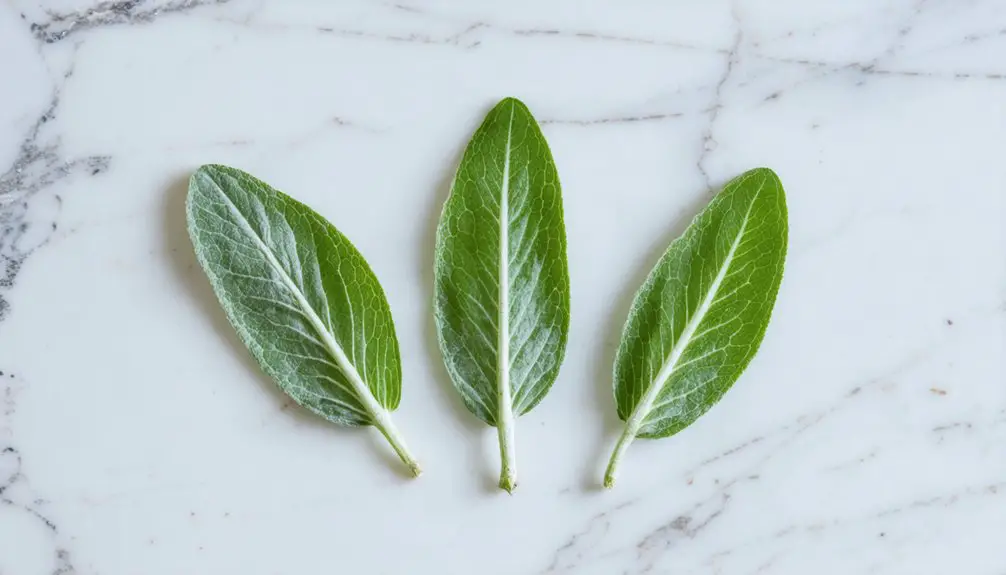
Safe implementation of sage-based whitening requires careful attention to proper usage protocols and precautions.
You’ll want to avoid directly rubbing raw sage leaves on your teeth, as this can damage your enamel and increase sensitivity. Instead, opt for professionally formulated products containing sage extracts.
To protect your oral health, maintain moderate use of sage preparations and incorporate them into your regular oral hygiene routine without overuse.
Practice moderation with sage-based whitening products and make them part of your regular dental care without excessive use.
If you have sensitive teeth or gum recession, exercise particular caution and consider consulting your dentist first.
After any sage whitening treatment, rinse thoroughly and use fluoride toothpaste to strengthen your enamel.
You’ll also need to avoid acidic beverages and staining foods immediately following treatment.
Remember to continue regular dental cleanings to monitor your enamel’s health during whitening regimens.
Combining Sage With Other Natural Whitening Ingredients
While sage offers notable whitening properties on its own, combining it with other natural ingredients can considerably amplify its tooth-brightening effects.
You’ll find that integrating complementary elements into your whitening rituals can enhance both the effectiveness and therapeutic benefits of your sage infusion treatments.
- Mix dried sage with baking soda and a pinch of salt for a gentle twice-weekly whitening scrub that removes surface stains without harsh chemicals.
- Combine sage with mint extract to create a potent natural whitening solution that delivers noticeable results within 10 days.
- Add clove powder and olive oil to your sage treatment for enhanced antiseptic properties and sustained plaque reduction.
- Integrate neem with sage-based oral care to target bacterial biofilm while supporting thorough tooth whitening and gum health.
Long-term Benefits of Sage-Based Oral Care
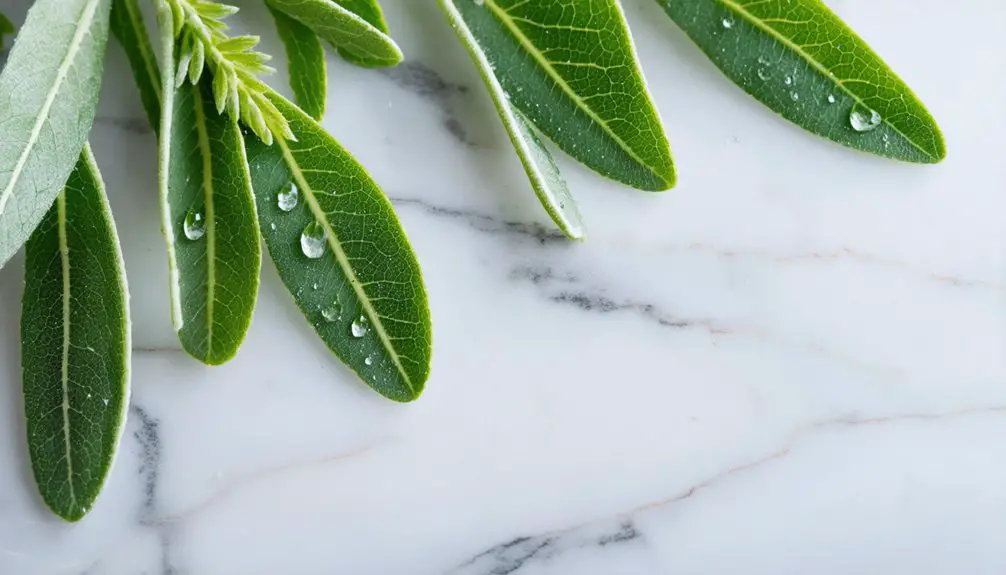
You’ll notice significant improvements in gum health when using sage-based oral care consistently, as its natural anti-inflammatory compounds help maintain healthier periodontal tissues while reducing bleeding and swelling.
The herb’s ability to control bacterial biofilm formation creates a sustainable oral environment that prevents plaque buildup and supports long-term dental hygiene.
Your daily sage regimen establishes a natural defense system against harmful oral bacteria, effectively maintaining a balanced microbiome without harsh chemicals or synthetic additives.
Sustainable Gum Health Benefits
Because maintaining oral health requires consistent, long-term solutions, sage-based oral care offers remarkable sustainability benefits for gum health.
You’ll find that sage’s natural compounds work continuously to protect and strengthen your gum tissue while supporting proper oral hygiene practices. Its powerful combination of antioxidants, anti-inflammatory agents, and antimicrobial properties creates a thorough approach to lasting oral wellness.
- Regular sage use reduces bacterial resistance risk compared to chemical antimicrobials, making it a safer long-term solution.
- Over 160 polyphenols in sage provide ongoing protection against free radical damage to gum tissues.
- Consistent use helps maintain balanced oral microflora, preventing chronic gum issues.
- Daily sage-based care delivers sustained anti-inflammatory benefits, protecting gum integrity and preventing recession.
Natural Biofilm Control System
Since biofilm formation poses a significant challenge to oral health, sage’s natural biofilm control system offers an all-encompassing solution through multiple mechanisms.
You’ll benefit from sage’s gentle abrasiveness, as its slightly rough leaves provide natural cleansing action when applied to teeth surfaces. The plant’s antimicrobial compounds target harmful bacteria while preserving your oral microbiome’s beneficial balance.
What makes sage particularly effective is its sustained action. Regular use of sage-based oral care products can reduce plaque thickness and prevent re-accumulation through both physical and biochemical means.
The rosmarinic acid, flavonoids, and essential oils in sage work together to disrupt bacterial adhesion and biofilm formation, while supporting long-term gum health. Unlike harsh chemicals, sage maintains enamel integrity while delivering consistent biofilm control.
What to Expect When Using Sage for Teeth Whitening
When using sage for teeth whitening, it’s important to set realistic expectations about the results. The herbal benefits of sage include gentle stain reduction and bacterial control, but you’ll notice subtle changes rather than dramatic transformations. Understanding these sage uses helps you maximize its potential while avoiding disappointment.
Sage offers natural teeth whitening through gentle stain removal, but expect gradual improvements rather than instant, dramatic results.
- You’ll experience gradual whitening effects that develop over several weeks of consistent use, unlike immediate results from chemical treatments.
- You’ll notice improved oral hygiene and fresher breath due to sage’s natural antibacterial properties.
- You can safely combine sage with your regular dental care routine without risking enamel damage.
- You might find that sage-based products, when used correctly, help maintain results after professional whitening treatments while protecting your enamel’s integrity.
Choosing the Right Sage Products for Your Dental Routine
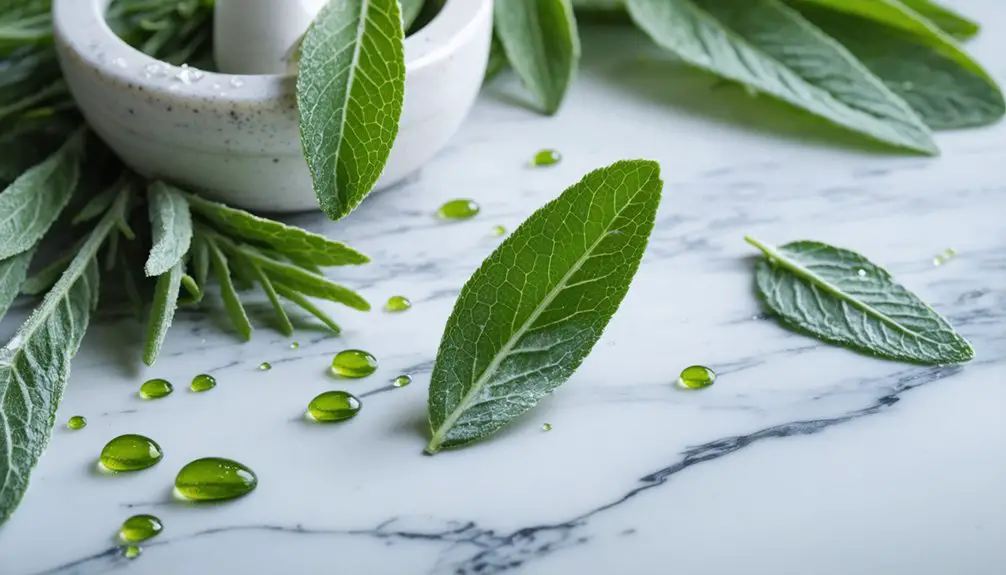
Now that you understand what to expect from sage-based teeth whitening, selecting the appropriate products becomes your next important step.
For ideal sage product selection, focus on organic or wildcrafted options that contain standardized sage extract concentrations and avoid synthetic additives like titanium dioxide.
Consider your preferred application method: powders and pastes work well for daily brushing routines, while diluted essential oil rinses provide antimicrobial benefits.
Pre-made gels offer convenient, precise dosing for at-home whitening. For dental routine integration, you’ll want to verify product certifications and check for complementary natural ingredients like coconut or lemon oil that enhance whitening effects while protecting enamel.
If you have sensitive teeth, opt for gentler formulations and always conduct a patch test before beginning regular use.
Frequently Asked Questions
Can Pregnant Women Safely Use Sage-Based Teeth Whitening Products?
While sage may seem natural, its safety during pregnancy isn’t proven. You shouldn’t use sage-based whitening products while pregnant without your doctor’s approval. Pregnancy precautions suggest waiting until after delivery.
Does Sage Teeth Whitening Work on Dental Crowns and Veneers?
You won’t see sage effectiveness on dental restorations like crowns and veneers since these artificial materials don’t respond to natural whitening agents that work on real tooth enamel.
How Long Does Sage-Whitened Teeth Stay White Without Maintenance?
While no studies specify exact sage longevity, you’ll notice whitening effects fade within days or weeks without maintenance. You’ll need regular applications and good oral hygiene to maintain results long-term.
Will Sage Stain My Tongue or Affect Taste Buds?
You won’t experience tongue staining or taste bud damage from sage benefits. Unlike substances like turmeric, sage’s mild pigments don’t cause tongue discoloration and won’t affect your taste perception.
Can Children Under 12 Use Sage for Teeth Whitening?
Despite sage’s benefits, you shouldn’t let children under 12 use it for teeth whitening. Their developing teeth need protection, and dental safety guidelines recommend waiting until permanent teeth fully mature around age 15.
References
- https://pmc.ncbi.nlm.nih.gov/articles/PMC4676988/
- https://www.genesispub.org/evaluating-the-clinical-efficacy-of-a-non-peroxide-dental-whitening-strip
- https://globalresearchonline.net/ijpsrr/v79-2/16.pdf
- https://pmc.ncbi.nlm.nih.gov/articles/PMC10630018/
- https://springcreekforestdental.com/natural-herbs-for-teeth-whitening-enhance-your-smile-the-natural-way/
- https://timesofindia.indiatimes.com/life-style/health-fitness/health-news/5-natural-herbs-that-help-whiten-teeth/articleshow/110584317.cms
- https://www.licdentalassociates.com/blog/2015/10/27/teeth-whitening/
- https://www.mymagnoliafamilydental.com/top-ten-natural-herbs-for-teeth-whitening/
- https://aanmc.org/naturopathic-kitchen/health-benefits-of-sage/
- https://alkmene.de/en/wirkstoffe/sage-effects-on-teeth/
